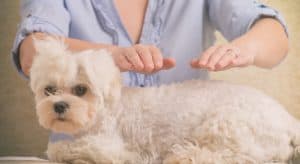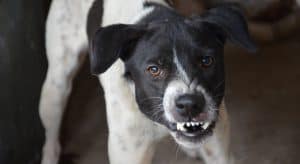If your dog jumps on you when you come home from work or school, then you understand what an annoying and sometimes dangerous problem this can be. It can also be quite embarrassing when your dog jumps on guests who come into your home.
Understanding the behavior is the first step to solving the behavior problem.
Dogs jump up on you in order to say hello! Dogs are very social creatures.
When dogs greet one another they make eye contact. So naturally, they would like to greet their people with eye contact.
However, humans are on two feet and dogs are down on four paws. So in order for dogs to make eye contact, they need to jump up on you. Dogs want your attention and affection.
Dogs Can Get Confused
Therefore, they really do not understand why you reject them when they jump on you. They get confused and do not know how to receive the attention and affection they are looking for. So they jump on you again!
It becomes a vicious cycle of the dog jumping and the owner disapproving.
Myriad of Solutions
There are a myriad of solutions to teach your dog to stop jumping on people. We like to offer a variety of solutions for you to choose from. You need to find a solution you’re comfortable with implementing.
Also, different techniques work on different dogs. Thus, you need to find a solution that your dog finds influential.
Additionally, the size of dog may dictate which technique works best for the both of you. If the training method you choose does not work within a few days to a week; then try another method.
As always we advise you to use the least harsh form of Correction and work your way up the ladder. This will prevent you from overly correcting the dog and causing more problems.
Review Behavior Modification Theory
No matter what solution you choose, we first need to review some Behavior Modification Theory.
Verbal Signal
You need to find a specific ‘verbal signal’ that will indicate to your dog that you do not want him to jump on you, your kids your friends etc. We use the word “Off”.
‘Off’ will come to mean “Get off of me, get off of my friend, get off of the couch, get off of the bed etc. It will come to mean ‘ Remove Yourself’ from any or all of those things.
You don’t have to use the word “Off’, per se. You can use whatever verbal signal you would like. However, do not use the word ‘No’. Dogs hear the word ‘No’ all day long for one reason or another!
Also, do not use the word ‘Down’.
Most likely “Down” already means lay down. You do not want to use the same word for two completely different physical behaviors.
Replacement Command
Now that you have chosen your verbal signal (Off) for inappropriate jumping, you need something called a “Replacement Command”.
A replacement command is an acceptable behavior that your dog can perform instead of jumping on people that will allow him to get the attention and affection he is seeking.
We recommend using the command ‘Sit’. It is quick and easy and most every dog knows it.
So, the behavior modification sequence is
- “Off” (in a low pitched, abrupt voice ) and
- “Sit” (in a normal voice followed by praise, in a high voice, once executed).
- When your dog jumps on you, say Off and
- Sit with the voice pitch changes noted above.
This Training sequence will become more clear as we illustrate each problem-solving technique. Remember, start with a problem-solving technique that makes most sense to you for your own dog. They are not listed in any particular order.
One problem solving method for jumping on people is use the “Off” “Sit” Behavior Modification sequence described above while adding a Negative Reinforcer.
A negative reinforcer makes the consequences of your dog’s Behavior unpleasant. See our “Right from Wrong’” “Positive Negative Reinforcement’ article in the How do you Train a dog section.
In most cases, your dog may already have a strong habit strength of jumping on people. Therefore, using only verbal commands will likely be insufficient.
We are going to give an example using a Shake Can aka Penny Can as the negative reinforcer. To make a shake can, all you need to do is put 20 pennies in an empty, clean, dried out soda can. For many dogs, the sound of the can when you shake it is something that they find very unpleasant due to their sensitivity to sound.
The Shake Can aka Penny Can Method
- You walk into the house after work or school and your dog starts running over to you. You know he is preparing to jump in order to get attention and affection.
- Be at the ready with your Shake can as he approaches.
- If he jumps on you at this First greeting, say “Off” in a low pitch voice and Shake (It) the penny can rigorously!
The key to this method working is that the shake can needs to make a really big impact the first time you use it.
- Next, keeping the can out of view, tell the dog “Sit”.
- Then give him the attention and affection he was looking for by jumping on you in the first place.
- It is recommended that you give this attention and affection reward by kneeling or some how going down to his level.
- As the greeting ritual continues, if the dog jumps on you a second time, bring the penny can out and Show it to the dog as you say off.
- If this stops him, great, say sit and give praise & attention.
- If it does not stop him then shake the can, say Off , then Sit. Once he sits, go to his level and give him praise and attention.
- If the dog is still not understanding or having a hard time controlling himself and jumps on you a third time, just say it …Off.
- If he ignores the verbal command, then bring out the penny can and SHOW IT & say OFF.
- If he still ignores the verbal command and sight of the penny can then SHAKE IT and say OFF.
At any of these 3 junctures, when he gets off of you, say SIT and then give him attention and affection. What the dog learn is that if he jumps on a you, you will not give you affection. Rather you will SAY OFF- and if need be SHOW the penny can- and if need be SHAKE the can. But if he just sits, he will avoid this unpleasantness and immediately get attention.
After the initial introduction of the Shake Can, this sequence SAY IT< SHOW IT< SHAKE IT should be used each time you are working with this behavior problem.
We do not want to have to be shaking this can all of the time! It is merely a training tool. By using these three steps, you will be able to condition the dog to obey your words.
When your Dog is Not Sound Sensitive
Some dogs are not sound sensitive. So you may have to try this technique with another type of negative reinforcer.
Some other examples could include:
- Spray bottle / Squirt gun
- Collar correction/ Knee in the chest.
Spray Bottle
The spray bottle or squirt gun is a good technique for those dogs that are water sensitive. Fill the bottle with water and if the dog jumps give him a spray of water in the face as you say off and then tell the dog to sit as outlined above.
Collar Correction
A correction with a choke collar or kneeing the dog are the more harsh of the negative reinforcers. But for some dogs, it may be appropriate. Use these last, as overly correcting your dog could cause additional problems.
Hold Paws In Awkward Position
Another technique you can try, if your dog jumps on you is to hold him up by his paws in that awkward position. You’re not mad at the dog, but you’re not playing either.
Just hold him up in this position, being very still and boring and not making eye contact. Do this until the dog starts wiggling and squirming and is clearly exhibiting that he finds this unpleasant.
Keep him up in that position for as long as you can. When you release the dog, do so abruptly in a downward motion. In a low pitched voice say off and then give them the replacement command sit.
Then go down to his level and give him the attention and affection he was seeking.
What the dog will learn is if he jumps on you, he will be held up in this very uncomfortable, boring position. And then he will be scolded and jerked to the floor But if he sits, he will be praised.
Tip
This may not be the best technique if your dog is mouthy. He may start nibbling on your hands and this will confuse the lesson you were trying to teach him.
Brace Technique
Or you could use the brace technique. Picture your puppy bouncing across the room. You know he’s going to jump on you.
- Make a brace or block with your hands by holding them out fully extended, with your fingertips touching one another.
- You can move your hands depending on how high your dog jumps and just let him bonk his little puppy had against your hands.
- Don’t thrust down on him. Just let it happen naturally from the dog’s force.
- Tell him OFF , as he jumps in a low voice, then tell him SIT .
- Praise him for sitting and then go down to his level and give him the attention and affection he’s looking for.
Again he is going to catch on quick. He will learn when I jump I get bonked on the head and then I get scolded. But when I sit I get praised. And I get the attention and affection I’m looking for.
Alternative Techniques
If the previous two solutions feel too harsh for you and your dog, you could use the following idea:
Down on One Knee
When you get home from work or school, just get down on one knee and let your dog come up and greet you.
This takes away the need to jump because now the dog can make eye contact with you. Which is all he’s really looking for in the first place.
Ignoring the Dog
Some people also like to try the method of ignoring the dog. With this method, when the dog starts jumping on you, you are to turn your back on the dog, fold your arms, put your head down and be very still and ignore your dog physically and verbally. After a usually lengthy amount of time, your dog will get the message and walk away.
Ultimate Goal – Show that Jumping on you leads to unpleasant Consequences
No matter what technique you try and ultimately use; just remember that you are trying to show the dog that if he jumps on you, something unpleasant happens.
But if he sits, he gets the attention and affection he wants. Once this ‘clicks’ in your dog’s mind, he will learn that when he approaches a person, it is rewarding to Sit and it is unrewarding to jump.
If a technique does not work within a few days to a week, it probably is not going to be useful for training your dog not to jump on people Try a different technique.
One Final Tip
If your dog thinks he can get away with jumping on a person once out of ten times, he’ll keep trying. So make sure that everyone in the family is consistent with delivering this message of “Off” “Sit”.
To find out how to get your dog to stay Off of the couch see our Dear Labby Advice Column







